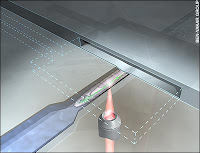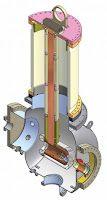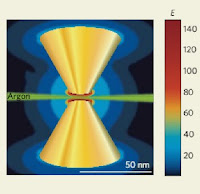 Femtosecond lasers have just become more accurate and versatile, thanks to Adela Ben-Yakar, mechanical engineering assistant professor at The University of Texas at Austin.
Femtosecond lasers have just become more accurate and versatile, thanks to Adela Ben-Yakar, mechanical engineering assistant professor at The University of Texas at Austin.By nature, Femtosecond lasers produce extremely brief, high-energy light pulses that can sear a targeted cell so quickly and accurately that the lasers’ heat has no time to escape and damage nearby healthy cells.
However, the very same laser systems, typically used in LASIK and other eye surgeries, have been too bulky - until now. Ben-Yakar’s laboratory has developed a femtosecond laser microscope system that includes a tiny, flexible probe that focuses light pulses to a spot size smaller than a human cell.
Ben-Yakar dubbed her creation the Microscalpel.
The Microscalpel can destroy a single cell while leaving nearby cells intact, which could improve the precision of surgeries for cancer, epilepsy and other diseases.
"You can remove a cell with high precision in 3-D without damaging the cells above and below it," Ben-Yakar says. "And you can see, with the same precision, what you are doing to guide your microsurgery."
As a result, the medical community envisions the lasers' use for more accurate destruction of many types of unhealthy material. These include small tumors of the vocal cords, cancer cells left behind after the removal of solid tumors, individual cancer cells scattered throughout brain or other tissue and plaque in the arteries.
Within a few years, Ben-Yakar expects to shrink the probe's 15-millimeter diameter by three-fold, so it would match endoscopes used today for laparoscopic surgery. The probe tip she has developed also could be made disposable -- for use operating on people who have infectious diseases or destroying deadly viruses and other biomaterials.
To develop the miniature laser-surgery system, Ben-Yakar worked with co-author
Olav Solgaard at Stanford University's Electrical Engineering Department to incorporate a miniaturized scanning mirror. Ben-Yakar and her graduate student Chris Hoy, another co-author, also used a novel fiber optic cable that can withstand intense light pulses traveling from an infrared, femtosecond laser.
To make the intensity more manageable, they stretched the light pulses into longer, weaker pulses for traveling through the fiber. Then they used the fiber's unique properties to reconstruct the light into more intense, short light pulses before entering the tissue.
For the study, Ben-Yakar directed laser light at breast cancer cells in three-dimensional biostructures that mimic the optical properties of breast tissue. She has since studied laboratory-grown, layered cell structures that mimic skin tissue and other tissues.
Ben-Yakar is also investigating the use of nanoparticles to focus the light energy on targeted cells. In research published last year, she demonstrated that gold nanoparticles can function as nano-scale magnifying lenses, increasing the laser light reaching cells by at least an order of magnitude, or ten-fold.
"If we can consistently deliver nanoparticles to cancer cells or other tissue that we want to target, we would be able to remove hundreds of unwanted cells at once using a single femtosecond laser pulse," Ben-Yakar says. "But we would still be keeping the healthy cells alive while photo-damaging just the cells we want, basically creating nanoscale holes in a tissue."
Ben-Yakar's experimental system is described in the June 23 issue of Optics Express.
Grants from the National Science Foundation and the National Institute of Health funded the research.

